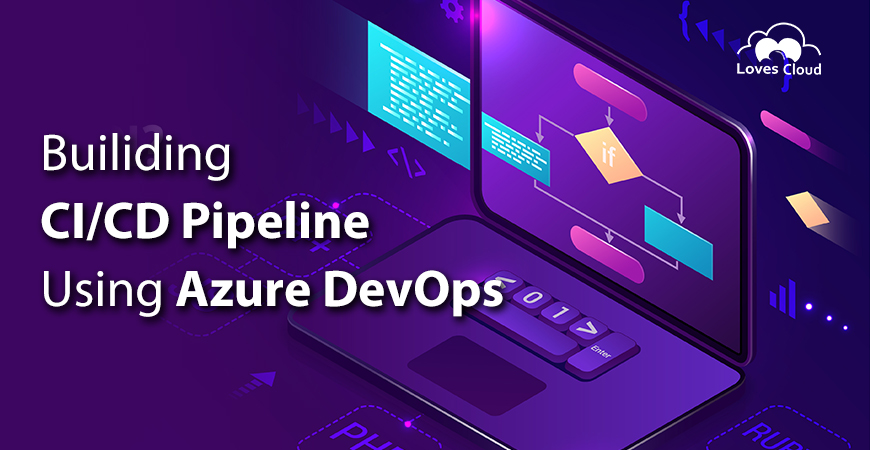
Building CI/CD Pipeline Using Azure DevOps
In business, “time is money.” Integration of CI and CD enables organizations to live up to that by resulting in faster builds and quicker delivery. By implementing continuous deployments, CI/CD helps them to monitor the project and provide real-time feedback while fixing shortcomings with the team whenever necessary. As a result, the end product they come up with has more refinement and is perfectly aligned with user expectations. Besides, CI/CD reduces the time-to-market thereby increasing ROI, helps build high-quality apps, empowers the development team, and pares down the overall project cost. It is indeed the backbone of DevOps that gives an organization’s digital transformation endeavours a big boost.
A few months back a client approached us with the requirement of building a CI/CD pipeline. They wanted a cloud-based environment to be set up for their software build and deployment processes. Azure DevOps build pipeline was our solution for them as it is known to provide an easier way to set up an automated pipeline in a fully cloud-based environment.
A brief customer profile
The client is a multinational professional services network provider with headquarters in London, United Kingdom. With footprints across 158 countries and manpower strength of over 250,000, they are one of the leading professional services networks globally. They work in both B2B and B2C domains delivering quality in assurance, tax, and advisory services.
What did we understand about the client’s challenges?
For a network as expansive as the client’s, deployment needs to be really fast to match the consumer demand. When that doesn’t happen, value creation takes a back seat. Slower deployment also means a below optimal productivity. Our client was facing all these challenges. Besides, bug reporting and fixing was not foolproof. An end-of-the-process security check meant there could be a risk of issues going unnoticed with the software product.
Goal-setting:
We discussed the problems at length with the company’s program manager and zeroed in on the following goals:
- We were to implement a CI/CD pipeline using Azure DevOps that would provide a cloud environment for software building and deployment
- To implement an efficient, continuous, automated deployment process that would expedite the entire project and reduce the time-to-market significantly.
How did we go about implementing the solution?
A clear understanding of the problem helped Loves Cloud to implement the solution in a time-bound manner. Using Azure DevOps we implemented an end-to-end CI/CD pipeline that took care of the client’s delivery and security issues while bringing down the cost. Below are precisely the steps we followed to achieve our goals:
- We implemented continuous integration and continuous delivery (CI/CD) pipeline using Azure DevOps.
- Then we implemented the Build Pipeline
- Once the build pipeline was implemented, we integrated GitHub with Azure DevOps
- Created a Tomcat deployment server on EC2
- Finally, we implemented the Release Pipeline
Tech stack we used for the solution implementation
We used the following tools, platforms, products, and services to implement the entire solution:
- Azure-Public cloud platform. Its following products were majorly used:
- Azure DevOps – for creating CI/CD pipeline
- Elastic Compute Cloud (EC2) – for hosting the Tomcat deployment server
- YAML was used as the language for scripting the programme.
Results were encouraging to say the least!
Along with reaching predefined goals, Loves Cloud was able to provide following benefits to the customer:
- Exponential reduction in deployment time
CI/CD pipeline building worked really well for our client. It exponentially reduced the software deployment time. Now, they can work with their favourite GIT provider and deploy to most of the major cloud services including Azure. This will increase their productivity too. By automating building, testing and software deployment, CI/CD pipelines will bridge the gap between software development and operation teams.
- Improved productivity due to continuous integration
Continuous Integration has evolved as one of the best practices in software development these days. By building CI Pipelines we were able to improve the productivity of the developers working with the company.
Predictable delivery, enhanced quality check
Our solution provided better quality check for the client’s software development process. The CI/CD Pipelines would now result in predictable deliveries- if any of the unit tests failed, nothing would get delivered at the end. This restricted Continuous Delivery would add value to our customer’s business by improving productivity to a significant extent.
Controlled releases out of stable build of choice
This pipeline maintains strict quality check at every stage. Continuous delivery (CD) ensures getting new builds to the users as fast as possible. It reduces the risks associated with releasing software and new features by ensuring that each update is smaller and can be delivered to users more frequently. It even makes sure that every change made to the underlying code of an application is releasable. By making controlled releases out of stable build, our client can now make their software development process even more efficient and less risky, and get quicker user feedback for further improvement.
It is this value-addition that we, at Loves Cloud, aim at in each of our project. We support various public cloud computing platforms along with multiple open source software solutions for making our customer’s digital transformation journey smooth. To learn more about our services aimed at the digital transformation of your business, please visit https://www.loves.cloud/ or write to us at biz@loves.cloud.

